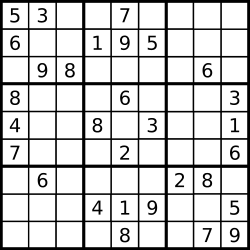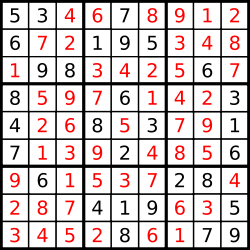37. Sudoku Solver
This problem reminds me the N-Queens problem: N-queens
Write a program to solve a Sudoku puzzle by filling the empty cells.
A sudoku solution must satisfy all of the following rules:
Each of the digits 1-9 must occur exactly once in each row.
Each of the digits 1-9 must occur exactly once in each column.
Each of the the digits 1-9 must occur exactly once in each of the 9 3x3 sub-boxes of the grid.
Empty cells are indicated by the character '.'.
A sudoku puzzle...

...and its solution numbers marked in red.

Note:
The given board contain only digits 1-9 and the character '.'.
You may assume that the given Sudoku puzzle will have a single unique solution.
The given board size is always 9x9.
- BackTraking
class Solution {
HashSet[] rows = new HashSet[9], cols = new HashSet[9], subs = new HashSet[9];
boolean find;
public void solveSudoku(char[][] board) {
for(int i = 0; i < 9; i++) rows[i] = new HashSet<Integer>();
for(int i = 0; i < 9; i++) cols[i] = new HashSet<Integer>();
for(int i = 0; i < 9; i++) subs[i] = new HashSet<Integer>();
for(int i = 0; i < 9; i++)
for(int j = 0; j < 9; j++)
if(board[i][j] != '.')
visit(board[i][j]-'0', i, j, getSubIndex(i,j));
backtrack(board, 0, 0);
}
public void backtrack(char[][] board, int i, int j) {
if(find) return;
if(j == 9) {
i++;
j = 0;
}
if(i == 9) {
find = true;
return;
}
int subIndex = getSubIndex(i, j);
if(board[i][j] != '.')
backtrack(board, i, j+1);
else {
for(int k = 1; k <= 9; k++) {
if(isValid(k, i, j, subIndex)) {
board[i][j] = (char)(k + '0');
visit(k, i, j, subIndex);
backtrack(board, i, j+1);
if(find) return;
cancel(k, i, j, subIndex);
board[i][j] = '.';
}
}
}
}
public void visit(int k, int i, int j, int z) {
rows[i].add(k);
cols[j].add(k);
subs[z].add(k);
}
public void cancel(int k, int i, int j, int z) {
rows[i].remove(k);
cols[j].remove(k);
subs[z].remove(k);
}
public boolean isValid(int k, int i, int j, int z) {
return !(rows[i].contains(k) || cols[j].contains(k) || subs[z].contains(k));
}
public int getSubIndex(int i, int j) {
return (i / 3) * 3 + (j / 3);
}
}